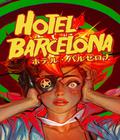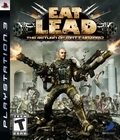Someone wants to kill Matt Hazard.
An action game icon whose rise to superstardom began in the late '80s during the Golden Era of 2-D, Matt Hazard's seemingly unstoppable career was derailed when he wanted to be in an RC racing game. It turned out to be one spin-off too many, single-handedly ruining the franchise and dooming him to bargain bins everywhere. Several years later, a new developer purchases the company that started Matt on the road to riches, thereby opening the door to a second chance to make his mark on platforms everywhere. As Matt discovers, someone wants to format his code faster than he can cheat his way into extra lives.
That's the premise for Vicious Cycle's Eat Lead: The Return of Matt Hazard, which introduces the player to a world where video game characters are real and live in their game worlds, kind of like movie stars waiting for the next sequel. If you love parodies, everything in the title pokes fun at nearly every genre, character stereotype, and broken gameplay mechanic.
Kid-friendly commandos armed with Super Soakers and a gaudy boss character inspired by JRPG stereotypes are all part of the creative twisting of reality. Levels are invaded by enemies from Matt's fictional history. Yakuza wannabes shoot it out with him in a Japanese steakhouse before he links up with old friends such as future sci-fi warrior, Master Chef, or an ally who suspiciously looks like everyone's famous plumber, only with a Russian accent. Or a mage with one of the worst William Shatner impressions ever.
Matt's likeable personality makes it easy to view his world through the dry wit and cynicism that he serves up. He spoofs many of the sacred cows that gamers have grown up with over the past few decades, but the jokes can quickly become old. Some of the blame can be placed on Matt's endlessly repetitive one-liners, and the rest is probably because the game tries too hard to include as many roast-worthy moments as possible; it makes the latter half of the title feel like a long, drawn-out punch line that gets lost in the retelling.
Despite the unique concept, most everything else feels like it's been left behind. The visuals appear lifted from one of Matt's games in the previous generation, but I don't think it was as intentional move. Blood is replaced with a safe, blue, digital burst of characters and numbers (likely to avoid a ratings scandal), flat textures plaster most every wall, and special effects are unimpressive, with colored clouds masquerading as explosions.
The character models, on the other hand, serve as a contrast because they don't look half bad. The music is a mix between hair metal from the '80s and riffs on genre-flavored pieces, such as a Halo-esque Space Marine theme, but it works as long as it doesn't skip out and stop playing. That was a technical glitch that occurred often enough for me to expect that I'd walk through most of a level without any theme music until the next scene came around to kick the soundtrack back to life.
As a third-person shooter, Matt Hazard doesn't attempt to rewrite the rules set forth by other big hits like Gears of War, but it also comes up short and feels dated. Clover's retro homage God Hand succeeded largely thanks to its balanced measure of humor and hardcore gameplay elements, which appealed to players who were looking for more than just a beat-'em-up. Matt Hazard tries far too hard to be funny without being fun, and when he says for the 10th time that he wishes he could throw grenades back, you start to wonder why he can't — along with being inability to jump and run.
As you can already guess, the controls are lacking. Without even trying anything new, they've managed to fail in accomplishing what is already taken for granted by most every other title. Not only is Matt unable to jump, but he also can't mantle over obstacles without first hiding behind cover and then executing a rolling maneuver on top of them to carry him to the other side. Matt also has one speed setting, so forget about sprinting ahead as you can in most any other title.
Being restricted to carrying only two weapons isn't so bad because there's not enough variety to really matter, but later on in the game, Matt can charge shots with frost or fire. Killing enemies releases energy that is stored in the ability meter, and once full, you can use the "powers" for a limited time, which can be helpful in fighting yet another batch of enemies that the title liberally sends at you.
Another piece of good news is that Matt has regenerating health, which allows him to recover once he finds a quiet spot away from the action. He can also use the low walls, endless crates, and almost anything else as cover, so he can lean around and blindly fire or aim for head shots. Players can shift views from shoulder to shoulder to get a better angle on their enemies, and death is largely meaningless thanks to a lightning-fast return to a previous checkpoint. There is some loading, such as between levels or in starting up the game, but it doesn't take long to get going. Weapons ranging from magnums to laser pistols round out the small arsenal of destructive firepower that Matt can use, though neither sounds or looks as powerful as you might expect it to be.
The blistering action isn't nearly as blistering as the bullet-riddled cover art may suggest. The incredibly formulaic action only knows to stir things up by throwing increasing numbers of disposable enemies at you. While many action titles do this, Eat Lead multiplies its monotonous array of baddies faster than RPG save games, making its gameplay about as exciting as playing an eight-hour game of whack-a-mole.
It might not have been so bad if the enemies weren't largely re-skinned clones of the same set of animation and AI routines or if the stages had some personality to add to the action. Matters would also have been improved if the game didn't recycle its small array of enemies halfway through, or if the enemies did more than perform the same two or three actions and then stop doing anything while shooting at you because their brains have turned off. In the first hour, you might hear everything that these goons have to say when they die, and by the time you reach the last stage, you may be thankful because it means that you won't have to hear yet another cheesy death scream.
As for the boss fights, most of these turn out to be Quick Time Events, with button presses and stick motion guiding Matt's fists and feet, turning what I expected to be a climactic contest into an interactive cut scene. Even the one or two "real" boss battles in the game suffer from their own flaws. In one example, fighting a tentacled boss beast is made even harder because of a camera that can get you killed, thanks to an off-screen fatality attack coming without any warning. As for most of the others, the boss battles aren't against the bosses themselves but against the nearly endless number of enemies that are sent to fight you, turning what should have been a pivotal moment into just about … any other game moment.
Misplaced power-ups make them useful in perhaps two or three areas where they appear, and they allow Matt to kill foes with enhanced damage or shield himself for a limited amount of time. Unfortunately, you often don't know where these bonuses are, even when your friend, QA, tries to "hack" them into the game to aid you, making them occasionally useless since you can't carry them to the next area.
Misspellings in the end credits are simply par for the course (empoyee? Eurpoean?), and with no multiplayer component, there's not much of an incentive to revisit any of the levels unless you want all of the Trophies that the game has to offer, love the unrelenting repetition, or have a taste for stale jokes. I wish I could have given Eat Lead: The Return of Matt Hazard a better score because the concept had a lot of potential, but the clever parody is ultimately hamstrung by this unfulfilled promise. The nuggets of genuine hilarity hidden within a few encounters are worth a once-over, but Matt Hazard's reboot should perhaps have been left for a later date.
Score: 5.5/10
More articles about Eat Lead: The Return of Matt Hazard











 Offering an original storyline and an off-the-wall cast of characters, written by 2008 Writers Guild Award winning writer Dave Ellis, D3Publisher's third-person shooter Eat Lead: The Return of Matt Hazard features the return of classic 80s videogame action hero, Matt Hazard, and parodies some of the most beloved genres of games and pop culture.
Offering an original storyline and an off-the-wall cast of characters, written by 2008 Writers Guild Award winning writer Dave Ellis, D3Publisher's third-person shooter Eat Lead: The Return of Matt Hazard features the return of classic 80s videogame action hero, Matt Hazard, and parodies some of the most beloved genres of games and pop culture.




























